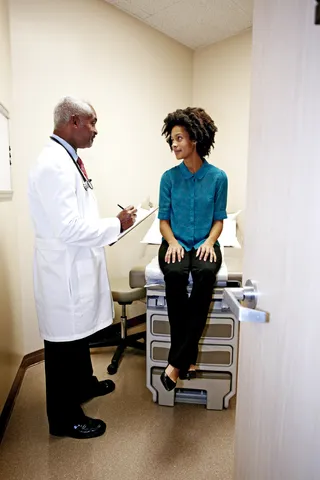Safe Sex Savvy: Everything You Need to Know About STDs
April is STD Awareness Month.

1 / 24
April is STD Awareness Month! - Sexually transmitted infections are more common than you think, but what do you really know about them? Use this month to get the scoop on the statistics, how they impact Black women and how to protect yourself. By Kellee Terrell(Photo: Wavebreak Media LTD/Wavebreak Media Ltd./Corbis)

2 / 24
STD Rates Are Alarmingly High - The Centers for Disease Control recently released new data around the current rates of sexually transmitted diseases (STDs) — and the news isn’t so great. Researchers say that STDs are at an all-time high and disproportionately impacting African-Americans, especially young Black women. (Photo: JGI/Jamie Grill/Blend Images/Corbis)

3 / 24
Breaking Down the Study - According to the CDC, in 2014, 1.4 million new chlamydia cases were reported in 2014, the worst it’s ever been with serious increases in gonorrhea and syphilis. Also, half of the 20 million new STD infections that occur each year are among people ages 15 to 24. (Photo:Liba Taylor/Corbis)

4 / 24
Race, Gender and STDs - Across the board, Blacks have higher rates for every STD tracked in the study. Black women were 5.7 times more likely to have chlamydia than white women; 10.7 times more likely to have gonorrhea; and 9.2 times more likely to have syphilis. One serious stat to chew on: of all of the gonorrhea cases, Blacks accounted for 54 percent, yet account for only 13 percent of the U.S. population. (Photo: Peathegee Inc/Blend Images/Corbis)

5 / 24
What About the Fellas? - According to the same study, Black men — heterosexual and gay/bisexual — didn’t fare much better. Black men were 7.3 times more likely to have chlamydia than white women; 10.6 times more likely to have gonorrhea, and 5.3 times more likely to have syphilis. The message is clear: Men have to worry about STDs, too. (Photo: Tetra Images/Corbis)
ADVERTISEMENT

6 / 24
Zika Cab Be An STD Too - Unless you’ve been living under a rock, you’ve heard of the Zika in passing. Zika, which can be spread by mosquitos and causes brain deformities in unborn babies, can also be spread through sexual contact. There have been documented cases of Zika spread this way in the U.S. (Photo: Sebastien Rabany/Photononstop/Corbis)

7 / 24
What’s Gonorrhea? - A pretty common curable bacterial infection, gonorrhea is an STD that can infect anyone. It can cause infections in the genitals, rectum, and throat. Some symptoms in women include painful or burning sensation when urinating, increased vaginal discharge, and vaginal bleeding between periods, says the CDC. In men, common symptoms are a burning sensation when urinating, a white, yellow or green discharge from the penis, and sometimes painful or swollen testicles. (Photo: Dr. Fred Hossler/Visuals Unlimited/Corbis)

8 / 24
The 411 on the Clap - Like gonorrhea, chlamydia is another curable common STD that can infect the genital, rectum and throat. If untreated, it can cause serious issues in women such as infertility and ectopic pregnancy. Common symptoms among women include abnormal vaginal discharge and burning sensation when urinating. Among men: Burning sensation when urinating, discharge from the penis, and sometimes painful or swollen testicles. (Photo: Dr. David Phillips/Visuals Unlimited/Corbis)

9 / 24
Understanding Syphilis - What was once believed to be an STD of the past is now back — and back with a vengeance. Syphilis is a curable disease that if not treated can have long-term complications. You can get syphilis by direct contact with a syphilis sore during vaginal, anal, or oral sex. According to the CDC, symptoms from the first stage appear in painless sores found on the penis, vagina, anus, in the rectum, or on the lips and in the mouth. The further the stages go untreated with this STD, the more dangerous it becomes as it can lead to blindness and even death. (Photo: 3d4Medical.com/Corbis)

10 / 24
Explaining Herpes - Genital herpes is an incurable viral infection that affects one out of every six people in the U.S. Genital herpes, a series of contagious painful blisters, is a virus that is spread through vaginal, anal and oral sex. You can also contract it by skin-on-skin contact. There is currently no vaccine or cure for genital herpes. However there is treatment that can help reduce the number of outbreaks you may have. (Photo: Lester V. Bergman/CORBIS)
ADVERTISEMENT

11 / 24
What’s HPV? - Genital human papillomavirus (HPV) is an STD that threatens Black women’s cervical health and causes cancer. There are more than 40 types of HPV and people can be infected in their genitals, rectums and throats. HPV can also cause genital warts, which can be removed. While there are HPV vaccines, there is no medical cure. The good news: HPV can clear itself in time, but in Black women that process take can longer, which makes them more vulnerable to cervical cancer. (Photo: LAGUNA DESIGN/Science Photo Library/Corbis)

12 / 24
Other Infections to Be Aware Of - There are other infections you should have on your radar, too. Be aware of pelvic inflammatory disease (infection of the reproductive organ), trichomonas (a very common infections caused by a parasite) and bacterial vaginosis (an infection where there is too much of a certain bacteria in the vagina). BV isn’t an STD per se, but it’s believed that having an STD can increase your risk of developing this infection and having a lot of sexual partners can disrupt the flow of good and bad bacteria in your vagina. (Photo: Dennis Kunkel Microscopy, Inc./Visuals Unlimited/Corbis)

13 / 24
How Exactly Are STDs Spread? - In many cases, they are spread through unprotected sex via semen, vaginal fluid and secretions as they get absorbed into cracks, lesions, sores and other openings in you or your partner's genitals and rectum. (Photo: Wavebreak Media Ltd./Corbis)

14 / 24
Oh…And It’s Spread Through Oral Sex - Penetrative sex isn’t the only mode to transmit an STD folks—you can get one from oral sex too. For example, if someone has oral herpes and performs oral on you, you can get herpes from that. This is why they invented dental dams. (Photo: Inti St Clair/Blend Images/Corbis)

15 / 24
Most STDs Show No Symptoms - We’ve all seen the “cauliflower” slides in school warning us about the dangers of STDs. But here’s what they might not be teaching you: Most STDs, especially in men and boys, show no symptoms. No discharge, no pelvic pain, no nothing. This is why many men don’t know they have an STD. (Photo: Liba Taylor/Corbis)
ADVERTISEMENT

16 / 24
Not All STDs Are Curable - As stated before, not all STDs are curable. Bacterial STDs such as syphilis and chlamydia are treatable with antibiotics, but viral ones such as herpes and genital human papillomavirus (HPV) don’t have a cure. Herpes can be managed with certain medicines. HPV, depending on the strain, can clear itself up over time. But in some women and men it can cause cancer and genital warts. (Photo: John Lund/Tiffany Schoepp/Blend Images/Corbis)

17 / 24
Condoms Don’t Protect You From All STDs - Using condoms from beginning to end in vaginal and anal sex is crucial to reducing your risk, but they don’t give you 100 percent protection from STDs such as herpes and HPV. Herpes in particular can be transmitted from skin-to-skin contact and your partner doesn’t have to have an outbreak for you to contract it. (Photo:Image Source/Corbis)

18 / 24
STDs Are Not Always Linked to Promiscuity - Yes, reducing the number of partners can reduce your risk of contracting STDs. But STDs don’t just happen to people who have a lot of partners. You can get an STD from a long-term boyfriend or girlfriend who may be infected and not even know. This is why it's really good to get screened for STDs when starting a new relationship, so you both can start off knowing your status. (Photo: 2/Hayley Baxter/Gallo Images/Ocean/Corbis)

19 / 24
FYI: A Pap Is Not An STD Test - This little tidbit is shocking for most of us. This is why when you got to the gyno you need to be very clear that you want to be screened for STDs. Don’t assume that’s what’s going on when your legs are in those stirrups. (Photo: Peathegee Inc/Blend Images/Corbis)
Photo By Photo: Peathegee Inc/Blend Images/Corbis

20 / 24
You Need to Get Tested and Treated - Having undiagnosed and untreated STDs can cause a range of health issues such as pelvic inflammatory disease, infections, scarring and infertility in women. Not to mention, you can continue to unknowingly infect other people. Your best bet: Get tested regularly and if you test positive make sure you and your partner(s) get treated. (Photo: Ton Koene/Visuals Unlimitd,/Corbis)
ADVERTISEMENT

21 / 24
STDs and Pregnancy - Getting tested and treated during pregnancy is KEY. These infections and viruses when not treated can wreak havoc on your little one causing low birth weight, brain damage, blindness, deafness, and even stillbirth. Not to mention, a mother can pass STIs to her baby during pregnancy and during delivery. (Photo: JGI/Tom Grill/Blend Images/Corbis)

22 / 24
Untreated STDs Make You Vulnerable to HIV Infection - Another downfall of having an untreated STD: HIV transmission is two to five times more likely. STDs lower your immune system, making you more vulnerable to becoming HIV-positive if you come into contact with the virus. And some STDs have open sores that make it easier for HIV to enter your body. (Photo: Hero Images/Corbis)

23 / 24
How Often Should I Get Screened? - According to the CDC, a sexually active woman who is having unprotected sex and/or has multiple partners is important to get screened every year. And make sure during this appointment you are very clear with the health-care worker that you want to be tested for STDs.(Photo: 2/Rob Melnychuk/Ocean/Corbis)
